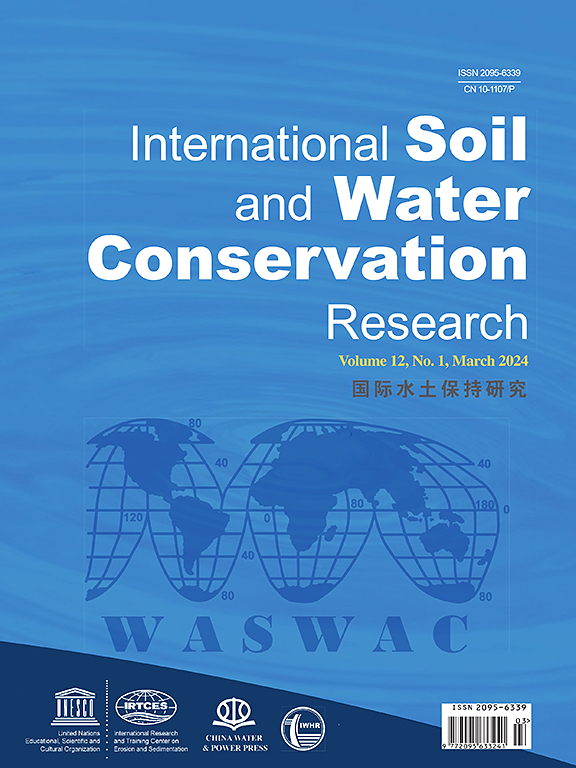Mitigating severe hydrological droughts in the Brazilian tropical high-land region: A novel land use strategy under climate change
IF 7.3
1区 农林科学
Q1 ENVIRONMENTAL SCIENCES
International Soil and Water Conservation Research
Pub Date : 2025-03-20
DOI:10.1016/j.iswcr.2025.03.005
引用次数: 0
Abstract
Severe droughts have significantly increased in frequency, magnitude, and intensity over the past decade, particularly impacting tropical and subtropical regions. Southeast Brazil exemplifies this trend, where severe hydrological droughts threaten the economy and society. We propose a novel approach to assess the impact of land use and climate change on severe hydrological droughts by integrating streamflow simulations with the Standard Hydrological Index (SHI), which is based on variations in water storage within the basin. To test our approach, the Lavras Simulation of Hydrology (LASH) model was applied to sixty-nine sub-basins in the upper Grande River basin, Southeast Brazil. We defined severe droughts as events where SHI ≤ −1.5, calculating threshold water storage (Sthreshold) for the baseline period (1961–2005) to evaluate the impacts of land use and climate change scenarios. Land use scenarios were designed to maintain stable agricultural areas, while climate change scenarios (RCP4.5 and RCP8.5) were projected through 2060. The findings indicated that forest recovery significantly reduced severe hydrological drought frequency, whereas deforestation intensified it. Sub-basins altered by human activity showed more susceptibility to climate change. However, forested sub-basins were notably impacted by land use changes, mainly from pasture replacing Atlantic Forest. Highlighting deforestation as a critical driver for regional hydrological vulnerability, our method underscores the urgent need for effective land use management and conservation strategies of Atlantic Forest to mitigate the risk of severe droughts, regardless of the climate change pathways.
缓解巴西热带高原地区严重的水文干旱:气候变化下新的土地利用策略
在过去十年中,严重干旱的频率、规模和强度都显著增加,特别是对热带和亚热带地区的影响。巴西东南部就是这一趋势的例证,那里严重的水文干旱威胁着经济和社会。我们提出了一种新的方法来评估土地利用和气候变化对严重水文干旱的影响,该方法将河流流量模拟与基于流域内储水量变化的标准水文指数(SHI)相结合。为了验证我们的方法,Lavras水文模拟(LASH)模型应用于巴西东南部格兰德河上游流域的69个子流域。我们将严重干旱定义为SHI≤- 1.5的事件,计算基线期(1961-2005)的阈值储水量(Sthreshold),以评估土地利用和气候变化情景的影响。土地利用情景旨在保持稳定的农业区,而气候变化情景(RCP4.5和RCP8.5)预测到2060年。研究结果表明,森林恢复显著降低了严重水文干旱的频率,而森林砍伐则加剧了严重水文干旱的频率。人类活动改变的子流域对气候变化的敏感性更高。森林亚流域受土地利用变化的影响显著,主要是牧场取代大西洋林。我们的方法强调了森林砍伐是区域水文脆弱性的关键驱动因素,强调了大西洋森林迫切需要有效的土地利用管理和保护战略,以减轻严重干旱的风险,无论气候变化途径如何。
本文章由计算机程序翻译,如有差异,请以英文原文为准。
求助全文
约1分钟内获得全文
求助全文
来源期刊

International Soil and Water Conservation Research
Agricultural and Biological Sciences-Agronomy and Crop Science
CiteScore
12.00
自引率
3.10%
发文量
171
审稿时长
49 days
期刊介绍:
The International Soil and Water Conservation Research (ISWCR), the official journal of World Association of Soil and Water Conservation (WASWAC) http://www.waswac.org, is a multidisciplinary journal of soil and water conservation research, practice, policy, and perspectives. It aims to disseminate new knowledge and promote the practice of soil and water conservation.
The scope of International Soil and Water Conservation Research includes research, strategies, and technologies for prediction, prevention, and protection of soil and water resources. It deals with identification, characterization, and modeling; dynamic monitoring and evaluation; assessment and management of conservation practice and creation and implementation of quality standards.
Examples of appropriate topical areas include (but are not limited to):
• Conservation models, tools, and technologies
• Conservation agricultural
• Soil health resources, indicators, assessment, and management
• Land degradation
• Sustainable development
• Soil erosion and its control
• Soil erosion processes
• Water resources assessment and management
• Watershed management
• Soil erosion models
• Literature review on topics related soil and water conservation research
 求助内容:
求助内容: 应助结果提醒方式:
应助结果提醒方式:


